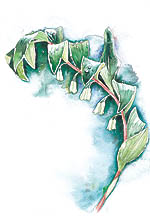

|
Plant Profiles: Polygonatum odoratum 'Variegatum'
Bulbous plant I'll make this quick and to the point: If you've got a shade garden and can spare four square feet, buy five of the variegated Solomon's seal, Polygonatum odoratum 'Variegatum'. In a few years, you'll be evicting nearby squatters and spending more time on your hands and knees. Here's a plant that draws you down to its level and makes you only wish you were that sublime. This woodland dweller is lit from within. Its airbrushed variegation works more like eyeliner than war paint, making its charm irresistible, even to those who generally shun foliage that thinks itself better than flowers. Certainly, the leaves are the reason to grow this plant. Their airy, fine-boned grace is an enormous relief among densely textured hostas and multistained heuchera, and their stature gives weight to finely dissected dicentras and ground-hugging asarums. But the early spring flowers are far from subtle, particularly massed, when hundred of creamy bells march two by two along the leaves. P. odoratum 'Variegatum' (a.k.a. P. odoratum var. thunbergii 'Variegatum' and P. falcatum 'Variegatum') is, in fact, made for massing, and showy enough to hold its own in a mixed border (protected from afternoon sun under a small deciduous tree). I've also seen it leading visitors through lesser-traveled part of the garden like lanterns along a path. Clearly, this form is my favorite among the genus, but a number of others work in equally versatile ways. For a dwarf groundcover, the species P. humile rarely exceeds nine inches, small enough to occupy a swath of shade in the rock garden, where it will offer intrigue as soon as its spears break ground. The East Coast native Solomon's seal, P. biflorum, breaks like a wave in a woodland setting, arched over creeping phlox, sweet woodruff, or sheets of moss. It generally tops out at three feet and is not particularly aggressive, leaving ample room for fall bloomers to obscure its dying leaves. If you're looking to fill space, consider the colonizing giant Solomon's seal (P. commutatum), which emerges a deceptively fragile and thin-skinned pale gray-green. It's a great, moist, edge of woodlands kind of plant that tends to gobble up the competition, making a sea of wafting, waving foliage often five to six feet high. No biblical association accounts for why polygonatum is called Solomon's seal, but I have unearthed a couple of explanations. In the category Least Likely to Be True, it's said that when you cut into a polygonatum rhizome, the cross section looks like a six-pointed Star of David. Another theory dates from the late-sixteenth-century Herball of John Gerard, who praises the root's ability to seal broken bones "...gotten by falls or women's willfulness, in stumbling upon their hasty husbands' fists." (Wretched wenches, always in the way.) But the most popular explanation is that the scars on the plant's rhizomes -- left by old leaf stems -- resemble an official wax seal. Only those with Solomon's wisdom know why it bears his name.
Plant Profiles are excerpted from Plant This! by Ketzel Levine
Copyright © 2003 National Public Radio, Washington, D.C. |
